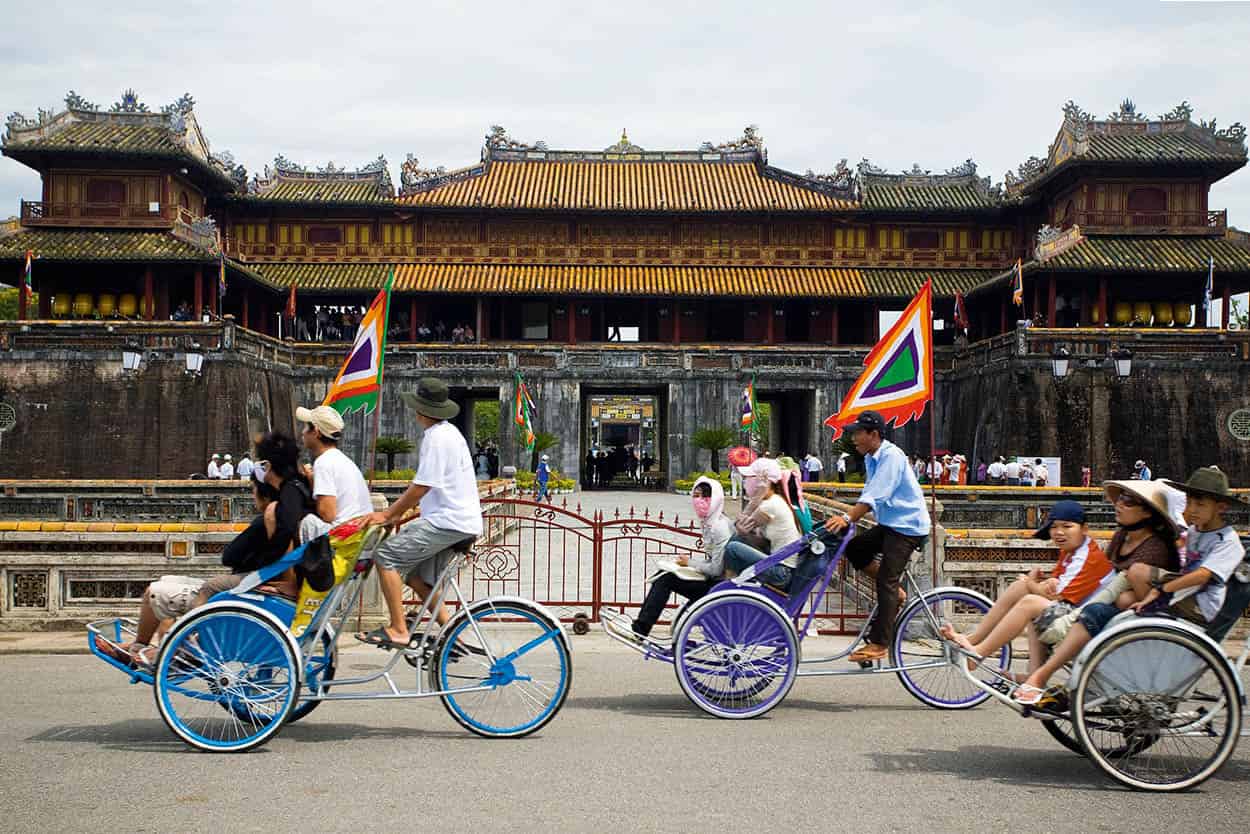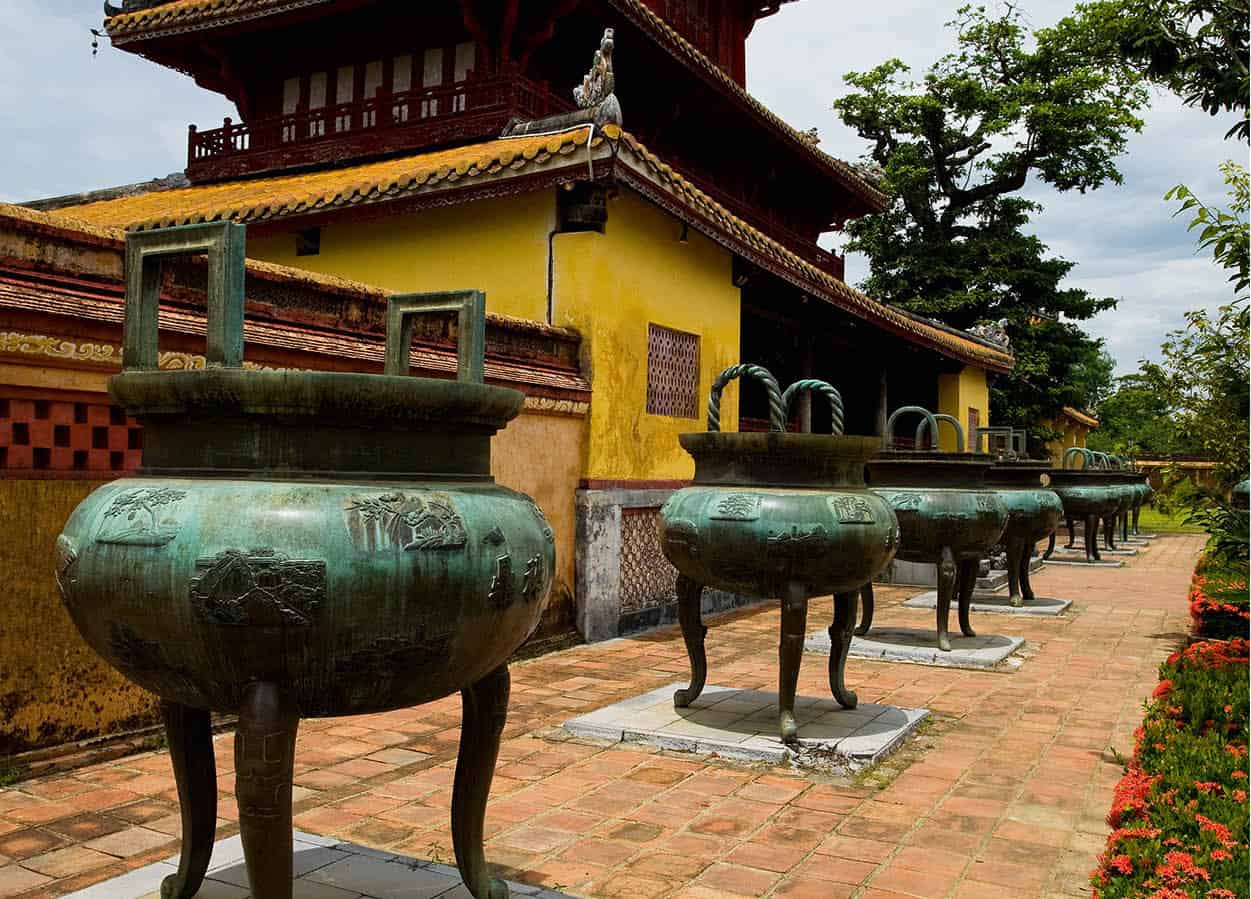DISTANCE: 1.5km (1-mile) walk
TIME: A half-day
START: Trang Tien Bridge on the Perfume River
END: Hue Historical and Revolutionary Museum
POINTS TO NOTE: Hue is best reached from Hanoi or Da Nang by train. Transport to and from the citadel is most convenient by taxi. This route is best grouped with route 11. Bring an umbrella unless there is a good reason to think it won’t rain, as Hue is one of the wettest cities in Vietnam. Plan to eat before or after the tour – there are no restaurants once inside the Ngo Mon. Time the route to take in one of the 30-minute shows (9.30am, 10.30am, 2.30pm and 3.30pm) at the Royal Theatre.
In 1802, after quelling the Tay Son rebellion, Lord Nguyen Phuc Anh proclaimed himself Emperor Gia Long and founded the Nguyen Dynasty. He ordered the new royal citadel to be built along the Perfume River, which became Vietnam’s new capital city. Just 33 years into the dynasty’s reign, the French invaded Hue. They retained the Nguyen Dynasty with nominal governance over central Vietnam and northern Vietnam. Thanks to French manipulation of the dynasty, a quick succession of emperors graced the throne, ending with Bao Dai’s abdication in 1945.

Trag Tien Bridge
Peter Stuckings/Apa Publications
Entering the citadel
Grab a bite at La Boulangerie Française, see 1, before heading north, crossing the Perfume River via Trang Tien Bridge 1 [map]. Enter the citadel on the north bank. Hue’s Imperial City (Dai Noi), including the Yellow Enclosure and Forbidden Purple City (Tu Cam Thanh), is enclosed within the all-encompassing Kinh Thanh (the exterior enclosure). Stone, bricks and earth were used for this wall, which was 8m (26ft) high and 20m (65ft) thick. Ten large, fortified gates, each topped with watchtowers, were built along the wall. Most of what visitors come to see today is within the Yellow Enclosure; other areas were destroyed during the Tet Offensive of 1968.
Immediately inside the first enclosure of the royal city, towards the Chuong Duc gate, are the Nine Deities’ Cannons 2 [map] (Sung Than Cong). The five cannons on one side represent the five elements – metal, water, wood, fire, and earth – while the other four represent the seasons.
The Yellow Enclosure (Hoang Thanh; daily 7am–5.30pm; charge) is the middle wall enclosing the Imperial City and its palaces, temples and flower gardens. Four richly decorated gates provided access: Ngo Mon (the southern gate, or Noon Gate), Hoa Binh (northern gate), Hien Nhon (eastern gate) and Chuong Duc (western gate).

Cyclos passing by Ngo Mon
Peter Stuckings/Apa Publications
The Ngo Mon
You will enter the Imperial City through the Ngo Mon 3 [map] (Noon Gate) was built of granite in 1834 during the reign of Minh Mang and is the most recognisable structure in the city. It is topped by the Five Phoenix Watchtower (Lau Ngu Phung).
From here, the emperors used to preside over formal ceremonies, including Emperor Bao Dai’s abdication. The gate is also known as the ‘Noon Gate’ because the sun, representing the emperor, is at its highest at noon. It faces south and is also therefore associated with prosperity. Purchase your tickets for the citadel here.
Thai Hoa Palace
Through the Ngo Mon, walk across the Golden Water Bridge, which at one time was reserved for the emperor. It leads to Thai Hoa Palace 4 [map] (Dien Thai Hoa) or ‘Palace of Supreme Harmony’, the most important administrative structure in the Imperial City. Here the emperor held bimonthly audiences with the court, including male members of the royal family, with civil mandarins standing before him on the left, and military mandarins on the right. The palace is in excellent condition, with its ceilings and 80 gilded beams decorated in red lacquer and gold inlay.
The Forbidden Purple City
Walking north through Thai Hoa, the Forbidden Purple City (Tu Cam Thanh) was reserved solely for the emperor and the royal family, who resided here behind a brick wall 4m (13ft) thick. This area was almost completely destroyed during the Tet Offensive of 1968 (the Viet Cong used the citadel as a bunker) and nearly everything that was left after that succumbed to flooding and neglect in tropical conditions.
When you first enter the area you’ll find the Left and Right Halls of the Mandarins. The Left Hall is now devoted to photo opportunities in period costumes (charge), and the Right Hall houses an extension of the Royal Antiquities Museum, with small exhibits of silver, bronze, wood and writing crafts from the Nguyen Dynasty.
The Royal Theatre 5 [map] (Duyet Thi Duong), behind and to the right (east), offers 30-minute shows in the morning at 9.30 and 10.30am, and afternoons at 2.30 and 3.30pm. Performances include five or six songs and dances in elaborate customs (including lion dancers).
The emperor’s Reading Pavilion sits behind the theatre, ornately decorated with tiles, although it looks like it could collapse at any time. A number of new covered walking corridors have been recreated in the central field, taking significant artistic licence. In the far reaches of the expanse behind them is a pair of octagonal Music Pavilions.

Th ai Hoa Palace
Peter Stuckings/Apa Publications
The temples
Return to the Thai Hoa Palace and walk west along the path to the next enclosure. The temple-shrines (mieu) here are dedicated to worshipping various lords and royal family members. The temple of Trieu To Mieu is devoted to Nguyen Kim (now used as a plant nursery), the Thai Mieu to Nguyen Hoang and his successors, and Phung Tien is a temple established to worship all of the emperors of the reigning dynasty, the To Mieu complex houses numerous shrines of significance as well. Hung Mieu is on the north side of the complex and devoted to Nguyen Phuc Luan, Gia Long’s father. The well-preserved The Mieu houses the shrines of nine Nguyen emperors.
Also in the To Mieu complex, in front of The Mieu temple, stands the magnificently restored Hien Lam Cac 6 [map] (Pavilion of Splendour), with the Nine Dynastic Urns (Cuu Dinh) lined up before it.

Halls of the Mandarins
Peter Stuckings/Apa Publications
Dien Tho Palace
Following the signs north, the Dien Tho Palace 7 [map], built in 1804, was the traditional residence of queen mothers. It includes a bewildering 20 structures, most notably the Phuoc Tho Pagoda, the recent Personal Residence of Emperor Bao Dai, and the lovely Truong Du Pavilion, nestled against a small lotus pond. The beauty of the complex rivals Thai Hoa Palace.
The Truong Sanh Residence is a separate complex behind the palace and served as a recreation area for the queen mother.
Hue Historical and Revolutionary Museum
Exit through Hien Nhon (the eastern gate) to the nearby Hue Historical and Revolutionary Museum 8 [map] (Bao Tang Tong Hop; Tue–Sun 7.30–11am, 1.30–5pm; free). The central building, built in the style of a traditional dinh (communal house), contains a collection of local archaeological discoveries. The colonial pavilions outside are devoted to the First and Second Indochina Wars.
End the royal tour by sampling a wide selection of unique dishes at the strip of three family-run restaurants known as Lac Thien, Lac Thanh and Lac Thuan, see 2, which can be found on the south side of the citadel.

The Nine Dynastic Urns
Peter Stuckings/Apa Publications
Food and drink
1 La Boulangerie Française
41 Nguyen Tri Phuong; tel: 054-383 7437; daily B, L & D; $
The Boulangerie is a French bakery selling tarts, cakes and breads that look great and taste even better, but it is best to come early for fresh goods. It also does excellent work by training disadvantaged street kids as bakers and pastry chefs.
2 Lac Thien, Lac Thanh and Lac Thuan
06 Dinh Tien Hoang; tel: 054-352 7348; daily B, L & D; $
This strip of three eateries owned by deaf siblings opened in 1965 and are the most famous in the city. They are known for giving customers their trademark wooden bottle-openers as souvenirs.

